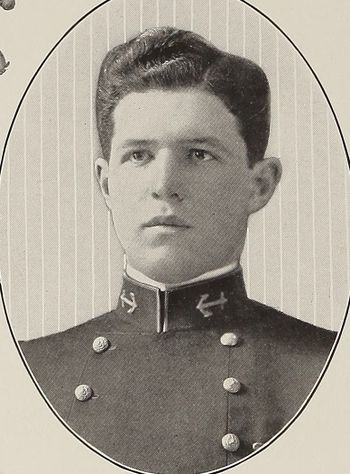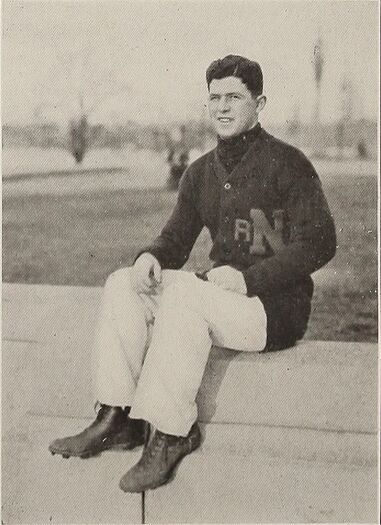ARNOLD MARCUS, LTJG, USN
Arnold Marcus '13
Lucky Bag
From the 1913 Lucky Bag:
Arnold Marcus
Mill Valley, California
"Marc"
MARC'S academic career has not been one continuous round of loafing. He has been in hot pursuit of that wary little animal called "Tufiv"; but he is in at the death, and his friends rejoice with him that the chase is ended without mishap. Widowed early in Second Class Year, when he lost Brutus—the noblest Roman of them all—Marc mourned the departed one faithfully, but the excitement of the above mentioned chase left him but little time for sorrow. Arnold is the easiest man in the world to rub along with on the basis of acquaintanceship, but very few have come close enough to be numbered with his friends. The playful spirit which sometimes moves him to douse the nearest man at mess with a glass of water is a source of endless gratification to those out of range, but it is a habit he will soon outgrow.
Rifle shooting is Marc's avocation; his success is attested by his place in Captain Jack Kates's aggregation of experts. Regardless of what he may have gained from the side issues of the course, he is a man who can step up to take his sheepskin with the proud feeling that he is getting something earned.
Rifle Team rNt, Sharpshooter—Expert, Clean Sleeve

Arnold Marcus
Mill Valley, California
"Marc"
MARC'S academic career has not been one continuous round of loafing. He has been in hot pursuit of that wary little animal called "Tufiv"; but he is in at the death, and his friends rejoice with him that the chase is ended without mishap. Widowed early in Second Class Year, when he lost Brutus—the noblest Roman of them all—Marc mourned the departed one faithfully, but the excitement of the above mentioned chase left him but little time for sorrow. Arnold is the easiest man in the world to rub along with on the basis of acquaintanceship, but very few have come close enough to be numbered with his friends. The playful spirit which sometimes moves him to douse the nearest man at mess with a glass of water is a source of endless gratification to those out of range, but it is a habit he will soon outgrow.
Rifle shooting is Marc's avocation; his success is attested by his place in Captain Jack Kates's aggregation of experts. Regardless of what he may have gained from the side issues of the course, he is a man who can step up to take his sheepskin with the proud feeling that he is getting something earned.
Rifle Team rNt, Sharpshooter—Expert, Clean Sleeve
Loss
Arnold was lost on July 25, 1917 when he died of injuries sustained the day before in a gasoline explosion and fire aboard the submarine USS A-7 (Submarine Torpedo Boat No. 8) while operating in Manila Bay. He was the boat's commanding officer.
Other Information
From researcher Kathy Franz:
Arnold’s wife was with him in Cavite. She accompanied his body home, and he was buried in Arlington National Cemetery on October 11, 1917.
Per The Bristol Herald Courier, October 16, 1917
The official investigation disclosed that after the explosion caused by the ignition of gasoline vapor by an electric switch, Lieutenant Marcus sent all of his men out of the hold before leaving himself; went to the bridge while suffering from burns which killed him, and personally took the helm with the idea of saving his ship by beaching her. When rescue ships took off the crew, Lieutenant Marcus refused to leave and asked that he be disregarded.
“It was shown from the evidence brought before the board,” Secretary Daniels wrote, “that the conduct of your husband was that of a most gallant officer, who, although fatally injured without regard to self, devoted every action and thought to the care of his vessel and men.”
Arnold’s father was born in Germany in 1839. Before her marriage in 1890, his mother’s stage name was Lillian Goldfinch. She had an excellent singing voice and was in several plays after her husband died. She was noted for her exquisite gowns, costly jewels, and her Titian red hair color. In 1900, the family lived on Chester Place in Englewood, New Jersey, with three servants.
From Pigboats:
Arnold Marcus, Jr. was born on June 26, 1892 to his mother, Lillian, who through her father’s line, traced her linage back to Thomas Becket and her father, Arnold Marcus, who was twenty five years her senior and a prominent banker in the greater New York metropolitan area. He had multiple interests in Banking, Investment Companies and Railroads. He also represented the Rothschild family investments during the Tammany Hall scandals.
Arnold Sr. died in 1905 leaving the family very well provided for. Arnold Jr. was educated, for the most part, in Germany. His mother loved to travel, and took him with her. After the death of Arnold Sr. the widowed Mrs. Marcus had ambitions of marrying into English nobility, and in 1908 married Lieutenant Colonel Sir Frank Popham Young. He was involved with the governing of India. Young Midshipman Arnold Marcus was the best man.
At age 10 Arnold Jr. is mentioned along with his mother in the society pages as to attending social events in the summer of 1902 at Newport with many other 'moneyed' families.
At age 15 he had apparently completed his overseas education, and was attending a prep school in advance to taking the Naval Academy entrance exams. He was to graduate from the Academy with the class of 1913.
His first duty station as a Midshipman was aboard the USS Pittsburgh CA-4. In 1914 he was detached from the Pittsburgh to duty on Asiatic station. He was to take an army transport ship to the Philippines on May 6, 1914.
It also seems he had service on the Intrepid and Vicksburg and the Milwaukee before being transferred to San Francisco to the Receiving ship there to wait the Army transport.
While aboard the Pittsburgh he met his future wife, Miss Helen Elizabeth Cowles, daughter of Mr. and Mrs. Paul Cowles, a prominent family of Chicago. They met while she was visiting family in San Francisco and he was in that port from duty aboard his ship that had been off the Mexican Pacific coast during the Vera Cruz landings.
Helen and her parents travelled to Hawaii together and then Helen travelled to the Philippines alone to marry Arnold there since he couldn't get leave. Her parents were cruising to the orient on their honeymoon as her father had just remarried. Helen and Arnold were married in Manila in the summer of 1915. She made several trips back to Hawaii, and California during the next two years.
After arriving in the Philippines, on September 5, 1914, he was assigned to the USS Pampanga (PG-39), a schooner rigged gunboat built by the Spanish Navy, and captured in 1898. She retained her Spanish name. In her lifetime, she was commissioned and decommissioned by the US Navy four times. On June 2, 1915, Marcus was detached from the Pampanga, to temporary duty on the armored cruiser Saratoga ACR-2, the former USS New York.
On July 2, 1915, he was once again transferred from the Saratoga to the USS Helena (PG-9), an American Gunboat. He was subsequently transferred on July 16, 1916 to the USS Monadnock (BM-3), an iron‑hulled, twin‑screw, double‑turreted monitor of the Amphitrite class that saw service in the Spanish American War.
On August 29, 1916 he was commissioned a Lieutenant jg, retroactive to June 7, 1916, and in early spring 1917, Marcus was ordered to command of the USS A-7.
On July 24, 1917, Marcus and his crew were running drills with the A-7 on Manila Bay when the submarine suffered an explosion. The A-7 was commissioned in 1902 and had a gasoline engine that had been overhauled a short time before this trip. Fumes were always a problem, and some vapors had settled in a bilge pocket, and built up. There was a spark when an electrical switch was thrown. It was followed by an explosion causing severe burns, and setting the interior on fire. Marcus and his men battled the blaze until he ordered the crew topside, and into the boats that had been summoned alongside. Marcus was the last man to emerge from the interior of the crippled submersible. He sent up distress signals to the nearby monitor Monadnock, and then took the helm himself in an attempt to beach the submarine.
He refused all attempts of personal assistance until all his men were removed from the A-7. One had died almost at once from the blast; seven later died in the hospital from complications as a result of their burns, and two survived though they had burns also. Once every crewman was off the submarine, he finally submitted to being taken from the vessel for treatment. He died the next day.
Ultimately, all the bodies of the men who died from the explosion on the A-7 were shipped to the United States for burial.
The dead were: Lt jg Arnold Marcus Jr, of Mill Valley, Cal. died the next day in the Canacao Naval Hospital, July 25, 1917. Buried at Arlington National Cemetery Plot: Section E Div Site 3808.
Jesse Mellon Currie, Chief Electrician, he also died the next day in the Canacao Naval Hospital, July 25, 1917. Buried in Oakwood Cemetery in his hometown Richmond, Virginia.
Ira Dell Hixon, Machinist's Mate, Second Class, from Yakima, Wash., also died the next day in the Canacao Naval Hospital, July 25, 1917. Buried; Tahoma Cemetery, Yakima, Washington. Plot: F 16 NW 2
Otho George Hopewell, Gunner's Mate, Second Class, of Brushy Knob, Mo. likewise died the next day in the Canacao Naval Hospital, July 25, 1917. Buried in Brushy Knob Cemetery in Vera Cruz, Missouri.
Arthur Martin Jacobs, Fireman Second Class, lived until August 1, 1917. Buried, Mare Island Cemetery, Vallejo, California. Plot: Section E, Row 02, Plot 614.
Joseph Anthony Kunz, Machinist's Mate, First Class, from Cameron, Texas, died the next day in the Canacao Naval Hospital July 25, 1917. No burial data.
Harold Holden Lang, Machinist's Mate, First Class, of Dorchester, Mass. died the next day in the Canacao Naval Hospital, July 25, 1917. Buried, Mountain View Cemetery, Cambridge, Vermont.
Theodore Schaiblin, Chief Electrician, home town of Greenwood, Mo., survived until Aug. 5, 1917. Buried, Mare Island Cemetery, Vallejo, California. Plot: Section E, Row 02, Plot 611.
The survivors were; Fireman Arthur M. Jacobs of Rigby, Idaho and J. P. Nixon, Machinist's Mate. Nixon was only slightly injured. All who died did so because of extensive burns that covered their bodies. Where the survivors went after the explosion isn't known at this time.
Arnold Marcus was buried with full military honors at 3:00 PM on October 10, 1917. Navy Chaplain Roundtree conducted the service at the Arlington Cemetery Chapel. His wife, Helen Marcus, had accompanied her husband’s body on the long trip from Manila to Washington, DC.
On August 22,1919 the destroyer USS Marcus DD-321 was commissioned in memory of Arnold Marcus Jr. and sponsored by his widow, Helen Cowles Marcus. His mother, Lady Young, was also present.
Secretary of the Navy, Josephus Daniels wrote a letter to the widow Marcus, and in it stated, "The conduct of your husband was that of a most gallant officer, who, though fatally Injured, without regard to self, devoted every action and thought to the care of his vessel and men."
Thanks to James Haas for additional information.
He was survived by his wife, Helen. He is buried in Arlington National Cemetery.
Photographs
Namesake
USS Marcus (DD 321) was named for Arnold; the ship was sponsored by his widow and is the first named for a submarine officer.
Memorial
Arnold's classmates erected a plaque to his honor in Memorial Hall.
The "Register of Commissioned and Warrant Officers of the United States Navy and Marine Corps" was published annually from 1815 through at least the 1970s; it provided rank, command or station, and occasionally billet until the beginning of World War II when command/station was no longer included. Scanned copies were reviewed and data entered from the mid-1840s through 1922, when more-frequent Navy Directories were available.
The Navy Directory was a publication that provided information on the command, billet, and rank of every active and retired naval officer. Single editions have been found online from January 1915 and March 1918, and then from three to six editions per year from 1923 through 1940; the final edition is from April 1941.
The entries in both series of documents are sometimes cryptic and confusing. They are often inconsistent, even within an edition, with the name of commands; this is especially true for aviation squadrons in the 1920s and early 1930s.
Alumni listed at the same command may or may not have had significant interactions; they could have shared a stateroom or workspace, stood many hours of watch together… or, especially at the larger commands, they might not have known each other at all. The information provides the opportunity to draw connections that are otherwise invisible, though, and gives a fuller view of the professional experiences of these alumni in Memorial Hall.
January 1915
January 1916
January 1917

The "category" links below lead to lists of related Honorees; use them to explore further the service and sacrifice of alumni in Memorial Hall.
